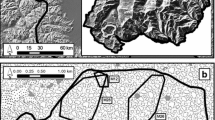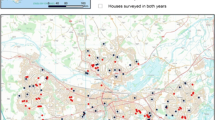Abstract
Walked spotlight transect surveys with distance sampling were used to estimate regional population densities of badger (Meles meles), fox (Vulpes vulpes) and brown hare (Lepus europaeus) in south-west England (Cornwall, Devon, Gloucestershire, Herefordshire) and Wales (Pembrokeshire, Borders, North Wales). All regions were surveyed during spring 2006 with English regions re-surveyed in autumn 2006. In each region, surveys were conducted in a random sample of 19.6 km2 areas (mean areas per region: spring = 19, autumn = 25). Within each survey area, a semi-random transect was established in each of a random sample of fields (open habitat almost exclusively pasture). Transects were subsequently walked at night with spotlights (mean transects per survey area: spring = 21, autumn = 21). Each area was surveyed twice during a season. Total transect length per region ranged from 137 to 193 km in spring and 230 to 250 km in autumn. The mean density of species per region was: badger 1.5–4.8 km−2, fox 1.0–4.0 km−2, hare 0.4–4.6 km−2. The study has provided baseline estimates of regional densities against which any future equivalent surveys can be compared. It has also illustrated the practical application of large-scale walked distance sampling to surveys of British mammals.



Similar content being viewed by others
References
Anderson DR, Burnham KP, Lubow BC, Thomas L, Corn PS, Medica PA, Marlow RW (2001) Field trials of line transect methods applied to estimation of desert tortoise abundance. J Wildl Manage 65:583–597
Buckland ST, Goudie IBJ, Borchers DL (2000) Wildlife population assessment: past developments and future directions. Biometrics 56:1–12
Buckland ST, Anderson DR, Burnham KP, Laake JL (2001) Introduction to distance sampling: estimating abundance of biological populations. Oxford University Press, Oxford
Cresswell P, Harris S, Jeffries DJ (1990) The history, distribution, status and habitat requirements of the badger in Britain. Report to the Nature Conservancy Council
Davison A, Birks JDS, Brookes RC, Braithwaite TC, Messenger JE (2002) On the origin of faeces: morphological versus molecular methods for surveying rare carnivores from their scats. J Zool 257:141–143
Delahay RJ, Langton S, Smith GC, Clifton-Hadley RS, Cheeseman CL (2000) The spatio-temporal distribution of Mycobacterium bovis (bovine tuberculosis) infection in a high density badger (Meles meles) population. J Anim Ecol 69:428–441
Durr PA, McDonald R, Sayers AR, Tait N, Howard D (2004) Prediction mapping of badger sett density in England and Wales using national spatial datasets. Gisvet 04:74–77
Edwards GP, de Preu ND, Shakeshaft BJ, Crealy IV (2000) An evaluation of two methods of assessing feral cat and dingo abundance in central Australia. Wildlife Res 27:143–149
Feore S, Montgomery WI (1999) Habitat effects on the spatial ecology of the European badger (Meles meles). J Zool 247:537–549
Harris S, Morris P, Wray S, Yalden D (1995) A review of British mammals: population estimates and conservation status of British mammals other than cetaceans. JNCC, Peterborough
Heydon MJ, Reynolds JC, Short MJ (2000) Variation in the abundance of foxes (Vulpes vulpes) between three regions of rural Britain, in relation to landscape and other variables. J Zool 251:255–264
Hone J (1988) A test of the accuracy of line and strip transect estimators in aerial survey. Aust Wildl Res 15:493–497
Hounsome TD, Young RP, Davison J, Yarnell RW, Trewby ID, Garnett BT, Delahay RJ, Wilson GJ (2005) An evaluation of distance sampling to estimate badger (Meles meles) abundance. J Zool 266:81–87
Hutchings MR, Harris S (1996) The current status of the brown hare (Lepus Europaeus) in Britain. Joint Nature Conservation Committee, Peterborough
Kay B, Gifford E, Perry R, van de Ven R (2000) Trapping efficiency for foxes (Vulpes vulpes) in central New South Wales: age and sex biases and the effects of reduced fox abundance. Wildlife Res 27:547–552
Knauer F, Kuchenhoff H, Pilz S (2010) A statistical analysis of the relationship between red fox Vulpes vulpes and its prey species (grey partridge Perdix perdix, brown hare Lepus europaeus and rabbit Oryctolagus cuniculus) in Western Germany from 1958 to 1998. Wildl Biol 16:56–65
Laing SE, Buckland ST, Burns RW, Lambie D, Amphlett A (2003) Dung and nest surveys: estimating decay rates. J Appl Ecol 40:1102–1111
Lord D (2001) A preliminary brown hare distribution survey of Cornwall, with reference to introductions. Occasional Paper No. 1, Environmental Records Centre for Cornwall and Isles of Scilly
Macdonald DW, Buesching CD, Stopka P, Henderson J, Ellwood SA, Baker SE (2004) Encounters between two sympatric carnivores: red foxes (Vulpes vulpes) and European badgers (Meles meles). J Zool 263:385–392
Marques TA, Buckland ST, Borchers DL, Tosh D, McDonald RA (2010) Point transect sampling along linear features. Biometrics 66:1247–1255
Neal E, Cheeseman C (1996) Badgers. T and AD Poyser Ltd, London
Pelletier L, Krebs CJ (1997) Line-transect sampling for estimating ptarmigan populations (Lagopus spp.) density. Can J Zool 75:1185–1192
Reynolds JC, Stoate C, Brockless MH, Aebischer NJ, Tapper SC (2010) The consequences of predator control for brown hares (Lepus europaeus) on UK farmland. Eur J Wildl Res 56:541–549
Ruette S, Stahl P, Albaret M (2003) Applying distance-sampling methods to spotlight counts of red foxes. J Appl Ecol 40:32–43
Southwell C (1994) Evaluation of walked line transect counts for estimating macropod density. J Wildl Manage 58:349–356
Thomas L, Buckland ST, Rexstad EA, Laake JL, Strindberg S, Hedley SL, Bishop JRB, Marques TA, Burnham KP (2010) Distance software: design and analysis of distance sampling surveys for estimating population size. J Appl Ecol 47:5–14
Trewby ID, Wilson GJ, Delahay RJ, Walker N, Young R, Davison J, Cheeseman C, Robertson PA, Gorman ML, McDonald RA (2008) Experimental evidence of competitive release in sympatric carnivores. Biol Letters 4:170–172
Webbon CC, Baker PJ, Harris S (2004) Faecal density counts for monitoring changes in red fox numbers in rural Britain. J Appl Ecol 41:768–779
Williams S (2003) Tracking the Dorset Hare. Dorset Wildlife Trust Report
Wilson GJ, Delahay RJ (2001) A review of methods to estimate the abundance of terrestrial carnivores using field signs and observation. Wildlife Res 28:151–164
Wilson G, Harris S, McLaren G (1997) Changes in the British badger population, 1988 to 1997. People’s Trust for Endangered Species, London
Acknowledgements
This study was funded by the UK Department for Environment, Food and Rural Affairs and the Welsh Assembly Government. We acknowledge all the landowners and farmers who permitted access to their land. Thanks are due to all those field staff who took part in the project. We would also like to thank two anonymous referees for comments on the manuscript.
Author information
Authors and Affiliations
Corresponding author
Additional information
Communicated by P. Acevedo
Anthony Prickett is now retired
Rights and permissions
About this article
Cite this article
Parrott, D., Prickett, A., Pietravalle, S. et al. Estimates of regional population densities of badger Meles meles, fox Vulpes vulpes and hare Lepus europaeus using walked distance sampling. Eur J Wildl Res 58, 23–33 (2012). https://doi.org/10.1007/s10344-011-0536-8
Received:
Revised:
Accepted:
Published:
Issue Date:
DOI: https://doi.org/10.1007/s10344-011-0536-8




